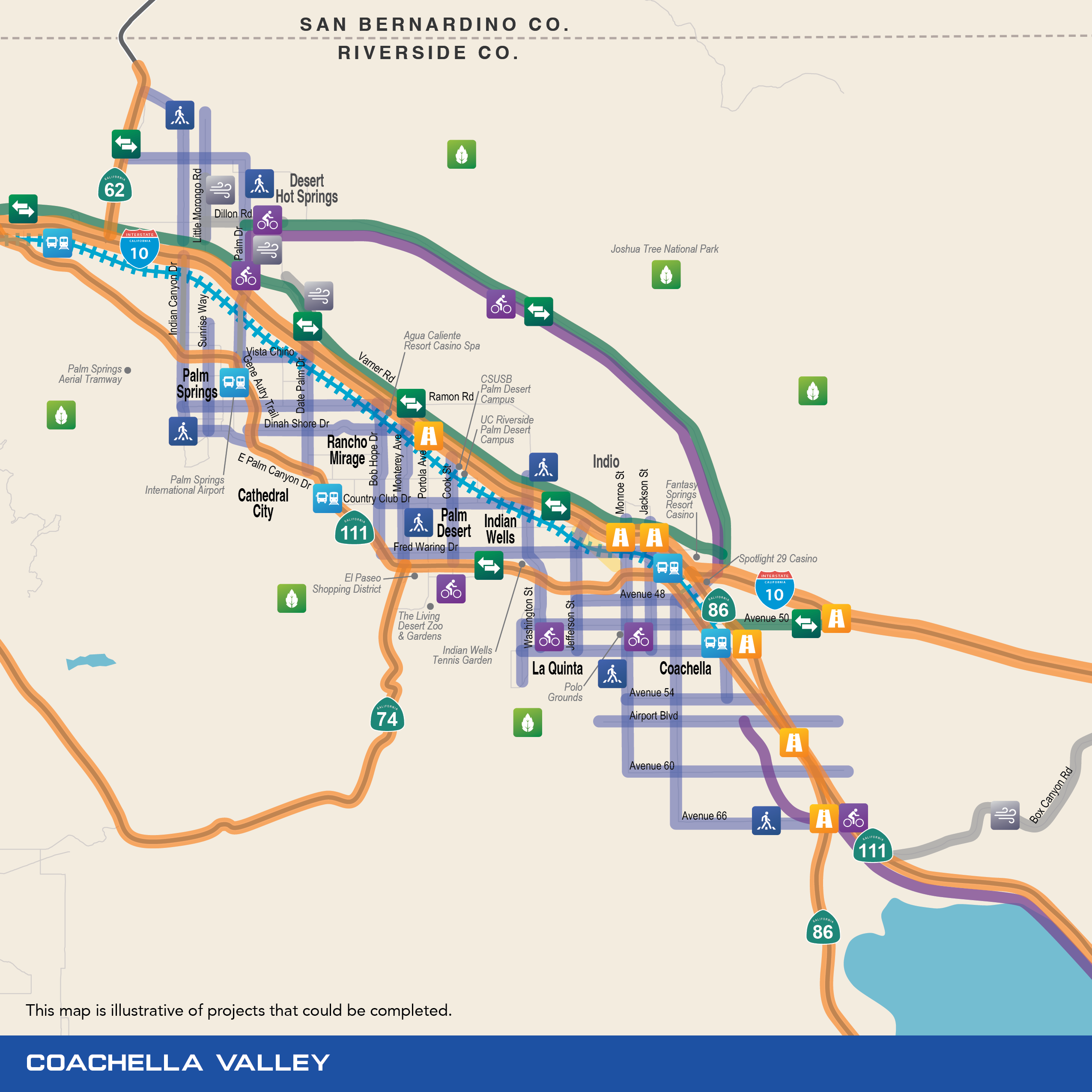Coachella Valley
The Traffic Relief Plan is a county-wide strategy to improve traffic flow and safety, keep infrastructure in good condition, provide greater access to public transportation, and keep Riverside County as a region of opportunity for its residents. RCTC developed the Plan based on feedback from Riverside County residents and their elected representatives.
All revenues generated in the Coachella Valley through a future ordinance and expenditure plan will remain in the Coachella Valley. The Coachella Valley Association of Governments (CVAG) will implement projects identified in the Plan in the Coachella Valley. Funding will provide investments for projects in communities that fully participate in, and are compliant with, the Coachella Valley’s Transportation Uniform Mitigation Fee (TUMF) and the procedures approved by the Coachella Valley Conservation Commission for the Coachella Valley Multiple Species Habitat Conservation Plan.
Since 1989, CVAG has been entrusted to manage the regional transportation network. CVAG establishes its priorities according to the Transportation Project Prioritization Study (TPPS), which is a merit-based method of prioritizing all regional projects in the Coachella Valley. The TPPS is updated every few years as the Coachella Valley’s population grows and becomes more diverse in order to address different mobility needs, new technologies, state and federal policy as well as worldwide climate and economic trends.
Safe Streets & Roads
The Plan will fund investments that extend the useful life of regional transportation corridors as identified in the TPPS. This Plan will provide for a regional pavement program implemented by CVAG in coordination with its members, with a focus on the rehabilitation and reconstruction of roadways that handle substantial amounts of non-local traffic. Additionally, the program will enhance existing efforts to promote uniform standards, keep transportation infrastructure in good condition, and extend the life cycle of Coachella Valley’s transportation infrastructure.
Examples include:
- I-10
- Highway 111
- Highway 86
- Ramon Road
- Cook Street
- Fred Waring Drive
- Gene Autry Trail/Palm Drive
- Indio Boulevard
- Washington Street
- Monterey Avenue
- Bob Hope Drive
- Dinah Shore Drive
- Date Palm Drive
- Little Morongo Road
- Avenue 50
Highways
Improving traffic flow on state highways by constructing new lanes, improving interchanges (on-and off-ramps and bridges) and public transportation facilities, and utilizing innovative technologies.
Examples include:
- Improve connections on I-10, State Route 86, Highway 111, Highway 62, and Highway 74
- Add Express Lanes on I-10
- Grade separations for State Route 86, including a new bridge at Avenue 50
- Expand Freeway Service Patrol to I-10 to quickly clear incidents from the freeway and keep traffic flowing
Regional Connections
Constructing multi-modal transportation corridors in the Coachella Valley.
Examples include:
- I-10 Bypass
- Extending Avenue 50 between I-10 and State Route 86
Public Transportation
- Expand daily passenger rail service (CV Rail) to the Coachella Valley from the Riverside, San Bernardino, Orange, and Los Angeles counties with the construction of new rail stations. CV Rail will transform, connect, promote sustainability, create access and equity, expand economic investment and tourism, and offer more travel choices for this rapidly growing region.
- Public transportation options for veterans, individuals with disabilities, seniors, students, and disadvantaged communities, including improving access to keeping these transit options affordable.
- Partner with employers in the Coachella Valley to encourage alternative forms of commuting, including rideshare and vanpool/carpool as a means to reduce congestion and improve air quality and safety.
Active Transportation
- CV Link extension to North Shore and Desert Hot Springs
- Expand on the existing active transportation network, such as the Palm Desert Link and bike improvements to the La Quinta village.
- Incorporating active transportation into the design of complete streets and creating multi-modal connections, such as improvements along Dillon Road.
- Accommodating electric vehicles such as golf carts and low-speed electric vehicles to better serve the mobility and independence among seniors, individuals with disabilities and underserved communities
Flood & Blowsand Control
- Building bridges and other resilient infrastructure along roads frequently closed due to blowsand and rainstorms, such as Indian Canyon, Gene Autry Trail, and Dillon Road, in addition to the communities of Palm Springs, Desert Hot Springs, and Cathedral City
- Projects to address persistent flooding along Box Canyon Drive
Environmental Mitigation
- Preserve the Coachella Valley’s natural areas and enhance infrastructure without environmental conflicts, including compliance with the Coachella Valley Multiple Species Habitat Conservation Plan.
